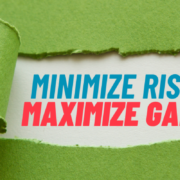Interest Rate and Home Price Swings
By Rick Tobin
Historically, the #1 reason why home prices generally rise, remain flat, or fall is directly related to the latest 30-year fixed mortgage rates. This is true because the vast majority of home buyers need third-party funds from banks, credit unions, or mortgage professionals to purchase and sell their homes to new buyers who also usually need bank financing to cash the seller out.
Over the past 10 years, a very high percentage of mortgage loans used to acquire residential (one-to-four unit) properties have originated, directly or indirectly, from some form of government-owned, -backed, or -insured money, such as FHA (Federal Housing Administration), VA (U.S. Department of Veterans Affairs), USDA (U.S. Department of Agriculture for more rural properties), Fannie Mae, Ginnie Mac, and Freddie Mac in both the primary and secondary markets. Most of these same government-assisted mortgage programs allow buyers to purchase properties with as little as no money down to just 3.5% down payments. Many times, the seller and family members can credit the most or all of the closing costs or down payment requirements so that the buyer really has no money invested in the property.
To the buyer, the most important part of the purchase deal is related to qualifying for a very low 30-year fixed mortgage rate and an affordable monthly payment. When the interest rates are too high, then fewer buyers can qualify for properties. During these higher rate time periods, home prices typically stay neutral or fall in price as seen during past periods of deflation like back in the mid-1970s. As such, almost all “boom” (positive) or “bust” (negative) housing cycles are directly related to low or high rates of interest, so they tend to correlate or go hand-in-hand with one another.
Interest Rate History: 1971 – 2018

Between 1971 and 2018, 30-year fixed-rate mortgages have ranged between a low of 3.31% in 2012 to a high of 18.63% in 1981. Fixed-rate mortgages are still hovering near historical lows at present and in recent years. An estimated 60%+ of mortgage holders are paying fixed-rates on their residential owner-occupied properties somewhere within the 3.00% and 4.90% rate ranges as of 2015, per data released by Freddie Mac.
During this same 47-year timespan (1971 – 2018), the average 30-year fixed-rate mortgage was near 8.08%. This rate is almost double the average 30-year fixed-rate mortgage loan between 2010 and 2019. Because the ease of qualification and the affordability of mortgage loans is typically the most important factor behind a booming or busting housing market, the more recent 3% to 5% rate ranges over the past 10 years has helped fuel a stronger housing market with rapid appreciation rates as well.
Most often, owner-occupants are using some type of a government-backed or insured mortgage loan and / or secondary market investor to purchase their properties. These loans include FHA, VA, Fannie Mae, and Freddie Mac. The typical down payment ranges used to purchase these properties are very likely to average somewhere within the 0% to 3.5% down payment range. Many times, the seller provides a credit towards most of the closing costs and / or another family member assists with the down payment as a gift of some sort.
If so, a very high percentage of owner-occupied home buyers have purchased their homes with little to no money down out of their own pocket prior to qualifying for tax-deductible mortgage payments that were less than a nearby apartment to lease. Additionally, these same homeowners have boosted their overall net worth after the vast majority of residential properties have appreciated at significant annual percentage rates. In some cases, homes have double in value in less than five to seven years due to the combination of affordable mortgage loans, easier mortgage underwriting approval processes, and increasing demand for properties to purchase.

Source: Freddie Mac’s Primary Mortgage Market Survey (PMMS)
The Consumer Debt Anchor

With home mortgages, the primary collateral for the loan balance is the home itself. In the event of a future default, the lender can file a foreclosure notice and take the property back several months later. With automobile loans, the car dealership or current lender servicing the loan can repossess the car.
Homeowners often refinance their non-deductible consumer debt that generally have shorter terms, much higher interest rates, and no tax benefits most often into newer cash-out refinance mortgage loans that reduce their monthly debt obligations. While this can be wise for many property owners, it may be a bit risky for other property owners if they leverage their homes too much.
With credit cards, lenders don’t have any real collateral to protect their financial interests, which is why the interest rates can easily be double-digits about 10%, 20%, or 30% in annual rates and fees, regardless of any national usury laws that were meant to protect borrowers from being charged “unnecessarily and unfairly high rates and fees” as usury laws were originally designed to do when first drafted.
Zero Hedge has reported that 50% of Americans don’t have access to even $400 cash for an emergency situation. Some tenants pay upwards of 50% to 60% of their income on rent. A past 2017 study by Northwestern Mutual noted the following details in regard to the lack of cash and high credit card balances for upwards of 50% of young and older Americans today:
* 50% of Baby Boomers have basically no retirement savings.
* 50% of Americans (excluding mortgage balances) have outstanding debt balances (credit cards, etc.) of more than $25,000.
* The average American with debt has credit card balances of $37,000, and an annual income of just $30,000.
* Over 45% of consumers spend up to 50% of their monthly income on debt repayments that are typically near minimum monthly payments.
Rising Global Debt

According to a report released by IIF (Institute of International Finance) Global Debt Monitor, debt rose to a whopping $246 trillion in the 1st quarter of 2019. In just the first three months of 2019, global debt increased by a staggering $3 trillion dollar amount. The rate of global debt far outpaced the rate of economic growth in the same first quarter of 2019 as the total debt/GDP (Gross Domestic Product) ratio rose to 320%.
The same IIF Global Debt Monitor report for Q1 2019 noted that the debt by sector as a percentage of GDP as follows:
- Households: 59.8%
- Non-financial corporates: 91.4%
- Government: 87.2%
- Financial corporates: 80.8%
Rate Cuts and Negative Yields
As of 2019, there’s reportedly an estimated $13.64 trillion dollars worldwide that generates negative yields or returns for the investors who hold government or corporate bonds. This same $13.64 trillion dollar number represents approximately 25% of all sovereign or corporate bond debt worldwide.
On July 31, 2019, the Federal Reserve announced that they cut short-term rates 0.25% (a quarter point). Their new target range for its overnight lending rate is now somewhere within the 2% to 2.25% rate range. This is 25 basis points lower than their last Fed meeting decision reached on June 19th. This was the first rate cut since the start of the financial recession (or depression) in almost 11 years ago dating back to December 2008.
There are three additional Federal Reserve two-day meeting dates scheduled for 2019 that include:
- September 17-18
- October 29-30
- December 10-11
It’s fairly likely that the Fed will cut rates one or more times at these remaining 2019 meeting dates. If so, short and long-term borrowing costs may move downward and become more affordable for consumers and homeowners. If this happens, then it may be a boost to the housing and financial markets for so long as the economy stabilizes in other sectors as well such as international trade, consumer spending and the retail sector, government deficit spending levels, and other economic factors or trends.
We shall see what happens between now and year-end in 2019 and beyond.

Rick Tobin
Rick Tobin has a diversified background in both the real estate and securities fields for the past 30+ years. He has held seven (7) different real estate and securities brokerage licenses to date, and is a graduate of the University of Southern California. Rick has an extensive background in the financing of residential and commercial properties around the U.S with debt, equity, and mezzanine money. His funding sources have included banks, life insurance companies, REITs (Real Estate Investment Trusts), equity funds, and foreign money sources. You can visit Rick Tobin at RealLoans.com for more details.












